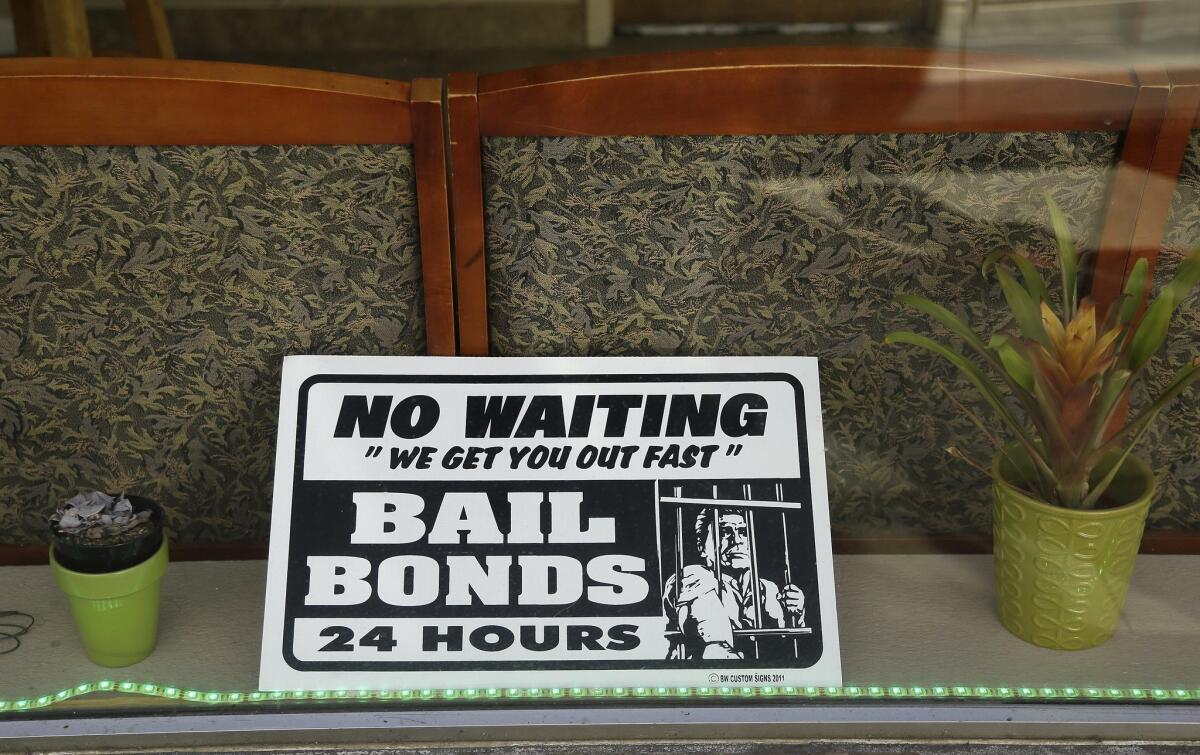Op-Ed: Freedom for sale in California – if you can afford it

A sign is seen in the window of a bail bonds office across from the Hall of Justice in San Francisco on Dec. 23, 2015.
On any given day, two-thirds of the people sitting in California jails haven’t been convicted of anything. These 42,000 people are simply awaiting their day in court, many of them incarcerated for no reason other than being too poor to post bail.
That fundamental unfairness is at the center of a federal case getting underway Tuesday in San Francisco. The class action suit asserts that California’s bail system allows rich people to buy their freedom while awaiting trial, but assumes poor people endanger community safety and can’t be trusted to show up on their court date.
The median [bail] amount in California is $50,000 -- five times higher than the national median. Most people don’t have anything close to that kind of cash available.
One of the lead plaintiffs is Riana Buffin, who was arrested in San Francisco on suspicion of theft and conspiracy, and jailed when she couldn’t produce $30,000 in bail money. The 19-year-old Oakland resident was given no opportunity to tell a court officer that she had a job, lived with her mom and three younger brothers, and posed no flight risk or danger to the community. A few days later, the charges against her were dropped. But because Buffin missed work while being jailed for a crime she didn’t commit, she lost her job as an airport baggage handler.
In California, the bail process varies depending on where you’re arrested. In some counties, judges can quickly release people to await their court date at home. But in others, like San Francisco County where Buffin was arrested, those without bail money are stuck.
Bail isn’t pocket change either. The median amount in California is $50,000 — five times higher than the national median. Most people don’t have anything close to that kind of cash available; a survey last year found 37% of Americans couldn’t cover even a $500 car repair bill. Many wind up turning to a bond company to get released. But bail bondsmen charge about 10% of the bail amount, money people don’t get back if charges are dropped. Still, people agree to that debt because a short stay in jail can cause major struggles, such as losing a job or custody of children.
Bail compounds the already substantial race and class discrimination problems rampant in the justice system. People of color experience higher arrest rates to begin with. Then they are charged with crimes that carry heavier sentences and in turn face higher bail amounts. Finally, those who can’t afford bail are more likely to give in to pressure to plead guilty. Research shows that those jailed while awaiting trial end up receiving longer sentences than people facing similar charges who are able to wait for their court dates at home.
The theory behind bail is that people are less likely to flee or commit a crime while awaiting trial if they will lose money as a result. However, studies have shown that those risks are more reliably assessed by looking at a combination of factors including having a job, family and community ties, and one’s history of substance abuse or prior arrests. These assessments are not perfect and have prompted concerns about bias given that, for instance, the unemployment rate for African Americans was about double that of white people in 2015. Still, such assessments represent an improvement over the status quo.
Counties such as Napa are showing the way. If you’re arrested there, a county probation department staffer will gather information about your personal circumstances and arrest history. An on-call judge uses this information to decide within 24 hours whether you can be released pending your court date and determines the appropriate level of supervision. Sometimes that’s as simple as a text message reminder of an upcoming court appearance. Other times, supervision includes mental health care or addiction treatment. In Napa County, more than 90% of those released pending trial show up for court and stay out of trouble in the meantime.
The cost of these pretrial supervision services ranges from $2.50 to $5 daily per person. Compare that with the $114 a day it costs to keep someone in jail. By moving to this kind of proven approach, California counties could save tens of millions of dollars a year and significantly reduce the number of people in jail.
The bail lawsuit could force San Francisco and maybe even the whole state to adopt pretrial supervision practices, but counties shouldn’t wait for a ruling to do the right thing. Counties have the authority to reform their bail systems now, and they should.
Zachary Norris is executive director of the Ella Baker Center in Oakland. Mary Lou Fulton is a senior program manager at the California Endowment.
Follow the Opinion section on Twitter @latimesopinion and Facebook
More to Read
A cure for the common opinion
Get thought-provoking perspectives with our weekly newsletter.
You may occasionally receive promotional content from the Los Angeles Times.










